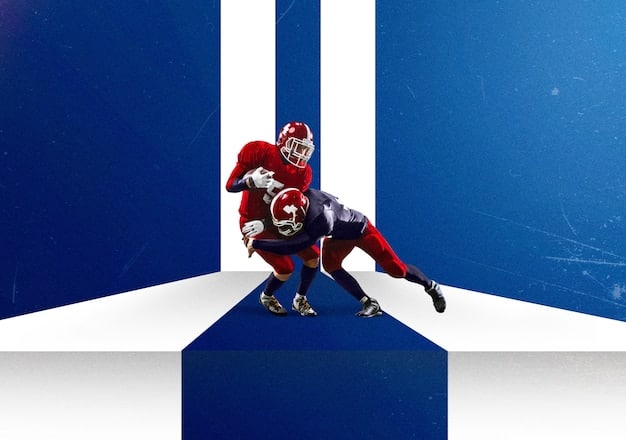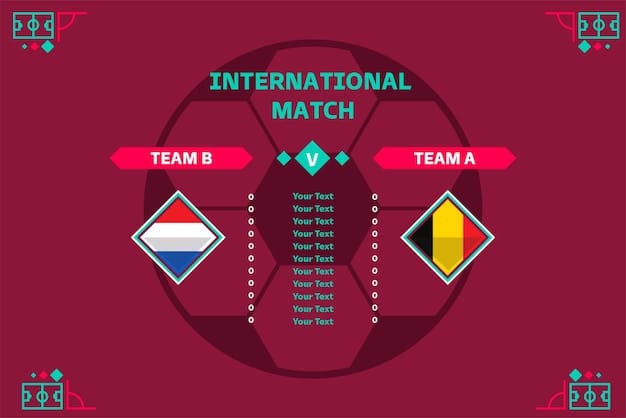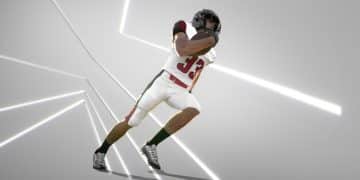King’s League USA: Defensive Records and Impact on Standings

The King’s League USA standings are significantly influenced by teams’ defensive records, with those showcasing stronger defensive capabilities generally achieving higher positions due to their ability to limit opponents’ scoring opportunities.
Dive into an analysis of the King’s League USA: The Teams With the Best and Worst Defensive Records – How Does It Impact Their Standings? This article explores how defensive prowess dictates team success and positioning within the league.
Understanding Defensive Metrics in King’s League USA
Defensive performance is a cornerstone of success in any competitive league, and the King’s League USA is no exception. Analyzing key defensive metrics provides insights into which teams are most effective at preventing goals.
Understanding these metrics is essential to grasping how defensive strength translates into tangible results in the league standings. Let’s delve into some fundamental aspects of defensive analysis.
Key Defensive Statistics
Several statistics are crucial in evaluating a team’s defensive efficiency. These metrics offer a comprehensive view of how well a team performs defensively.
- Goals Against (GA): The total number of goals a team has conceded. Lower GA indicates a stronger defense.
- Shots on Target Against (SoTA): Measures the number of shots a team faces that are on target. A lower number suggests the defense is limiting high-quality chances.
- Tackles Won: Indicates how often a team successfully dispossesses opponents. High tackle success rates often correlate with effective defensive play.
- Interceptions: Captures how frequently a team intercepts passes, disrupting the opposition’s build-up play.

Evaluating these statistics allows for a data-driven comparison between teams, revealing which ones excel defensively and areas where they can improve.
Top Defensive Teams in King’s League USA
Identifying the top defensive teams is crucial for understanding which strategies and players are contributing to success in the league. These teams often serve as benchmarks for defensive excellence.
Examining their strategies and key players can offer insights into replicating their success. Let’s explore some of the standout defensive teams in King’s League USA.
Team A: The Defensive Fortress
Team A has consistently demonstrated exceptional defensive capabilities, boasting the lowest goals-against record in the league. Here’s what sets them apart:
- Organized Backline: Their defenders maintain excellent positioning and communication, minimizing gaps for opponents to exploit.
- Effective Pressing: They employ a coordinated high press, forcing turnovers in the opposition’s half.
- Goalkeeping Excellence: Their goalkeeper has made numerous crucial saves, adding an extra layer of security.
Team B: Tactical Rigidity
Team B stands out for its tactical discipline and ability to execute defensive strategies flawlessly. Their defensive prowess is characterized by:
- Disciplined Shape: They maintain a compact defensive shape, making it difficult for opponents to penetrate their lines.
- Strategic Fouls: They strategically commit fouls to disrupt the opposition’s rhythm and prevent dangerous attacks.
- Aerial Dominance: Their defenders consistently win aerial duels, nullifying long balls and set-piece threats.
These top defensive teams exemplify the impact of strong defensive organization and individual brilliance on team performance. These examples highlight the combination of tactical execution and player skill.
Bottom Defensive Teams in King’s League USA
Conversely, analyzing teams with weaker defensive records can highlight common pitfalls and areas for improvement. Understanding these challenges is essential for addressing defensive vulnerabilities.
By identifying the factors that contribute to poor defensive performance, teams can implement targeted strategies to strengthen their backlines. Let’s look at teams that struggle on the defensive end.
Team C: The Leaky Defense
Team C’s struggles are largely due to their inability to maintain defensive solidity. Issues include:
- Poor Marking: Their defenders often lose track of their assignments, leading to unmarked players in dangerous areas.
- Lack of Communication: Miscommunication between defenders results in defensive lapses and easy scoring opportunities.
- Individual Errors: Costly individual errors frequently undermine their efforts, leading to unnecessary goals.
Team D: Tactical Disarray
Team D’s defensive woes stem from a lack of clear tactical structure and execution. Key issues include:
- Disorganized Pressing: Their pressing efforts are often disjointed, creating gaps for opponents to exploit.
- Vulnerable on Transitions: They struggle to defend against quick counter-attacks, leaving their defense exposed.
- Set-Piece Weakness: They are particularly vulnerable on set-pieces, conceding a high proportion of goals from corners and free kicks.
These bottom defensive teams illustrate the consequences of lacking defensive organization, communication, and sound tactical execution. They highlight areas where significant improvements are needed.

The Impact of Defense on King’s League USA Standings
The quality of a team’s defense directly correlates with its position in the league standings. Strong defensive teams often contend for the top spots, while defensively weak teams struggle to stay competitive.
This correlation is evident when comparing goals-against records with league positions. Here’s how defensive performance influences standings.
Correlation Between Goals Against and League Position
There is a clear trend: teams with the fewest goals against tend to occupy the higher positions in the league. This correlation underscores the importance of defensive stability in achieving success.
- Top Teams: Teams with stingy defenses are more likely to secure crucial points and maintain a consistent winning record.
- Mid-Table Teams: Teams with average defensive records often find themselves in mid-table positions, relying on offensive firepower to compensate for defensive vulnerabilities.
- Bottom Teams: Teams with porous defenses typically languish at the bottom of the standings, struggling to accumulate points due to their inability to prevent goals.
Case Studies: Defensive Turnarounds
Examining teams that have undergone significant defensive improvements can provide valuable insights. These turnarounds often lead to substantial gains in the league standings.
- Team X: By implementing a more structured defensive system and focusing on player discipline, Team X significantly reduced their goals against, leading to a climb in the standings.
- Team Y: Through targeted acquisitions of experienced defenders and improved communication, Team Y transformed their defense, resulting in a remarkable turnaround in their season.
These case studies demonstrate that focused efforts to improve defensive performance can yield significant dividends in terms of league position and overall competitiveness.
Strategies for Improving Defensive Performance
For teams looking to bolster their defensive capabilities, several strategies can be implemented. These strategies range from tactical adjustments to player development programs.
Implementing these strategies requires a holistic approach, focusing on both individual skills and team cohesion. Let’s explore some effective methods for improving defensive performance.
Tactical Adjustments
Adjusting tactical formations and strategies can significantly impact a team’s defensive solidity. Consider the following:
- Formation Changes: Switching to a more defensively oriented formation, such as a 5-3-2 or 4-5-1, can provide additional cover and protection for the backline.
- Defensive Midfielders: Employing strong defensive midfielders who excel at tackling, intercepting passes, and shielding the defense can add an extra layer of security.
- Pressing Strategies: Implementing a well-coordinated pressing strategy can disrupt the opposition’s build-up play and force turnovers in advantageous positions.
Player Development
Investing in player development programs aimed at enhancing defensive skills is crucial for long-term improvement. Key areas of focus include:
- Defensive Drills: Conducting drills that focus on tackling technique, positioning, and communication can sharpen defensive skills.
- Video Analysis: Utilizing video analysis to review defensive performances and identify areas for improvement can provide valuable learning opportunities.
- Physical Conditioning: Emphasizing physical conditioning to improve speed, agility, and strength can enhance players’ ability to compete defensively.
Future Trends in King’s League USA Defensive Strategies
As the King’s League USA evolves, defensive strategies are likely to become more sophisticated and data-driven. Anticipating these trends is essential for staying ahead of the competition.
Technological advancements and analytical innovations will play a pivotal role in shaping future defensive approaches. Let’s consider some potential future trends.
Data Analytics and Defensive Optimization
The use of data analytics will become increasingly prevalent in optimizing defensive strategies. Teams will leverage advanced metrics to:
- Identify Weaknesses: Pinpoint specific areas of defensive vulnerability and implement targeted strategies to address them.
- Optimize Positioning: Enhance defensive positioning based on the analysis of opponent movement patterns and passing tendencies.
- Predictive Modeling: Use predictive models to anticipate opposition attacks and proactively adjust defensive formations.
Technological Innovations
Technological advancements are set to revolutionize defensive training and performance analysis. Potential innovations include:
- VR Training: Virtual reality training simulations that allow players to practice defensive scenarios in a realistic and immersive environment.
- Wearable Technology: Wearable sensors that provide real-time feedback on player movement, positioning, and physical exertion.
- AI-Powered Analysis: Artificial intelligence systems that automatically analyze defensive performances and generate actionable insights.
| Key Point | Brief Description |
|---|---|
| 🛡️ Defensive Metrics | Goals Against, Shots on Target Against, Tackles Won, and Interceptions are crucial. |
| 🏆 Top Teams | Excel with organized backlines, effective pressing, and tactical discipline. |
| 📉 Bottom Teams | Struggle with poor marking, lack of communication, and tactical disarray. |
| 📈 Impact on Standings | Strong defense leads to higher standings; weak defense results in lower standings. |
Frequently Asked Questions
▼
Key stats include Goals Against (GA), Shots on Target Against (SoTA), Tackles Won, and Interceptions. GA is particularly important as it directly reflects a team’s ability to prevent scoring opportunities.
▼
They often emphasize organized positioning, effective communication between defenders, and strategic pressing to force turnovers. Goalkeeping excellence also plays a crucial role in securing their defense.
▼
Common problems include poor marking, a lack of communication between defenders, individual errors, and tactical disarray. These teams typically struggle to maintain a cohesive defensive structure.
▼
Yes, teams that implement structured defensive systems, improve player discipline, and focus on targeted acquisitions can drastically reduce goals conceded. Leading to significant improvements in league position.
▼
Expect a greater reliance on data analytics to optimize positioning and strategies, alongside innovations like VR training and AI-powered analysis to enhance player performance and tactical decision-making.
Conclusion
In summary, the correlation between defensive records and league standings in King’s League USA is undeniable. Teams with robust defensive strategies and disciplined execution are more likely to secure higher positions, highlighting the pivotal role of a strong backline in achieving overall success. As the league evolves, expect defensive tactics to advance through data analytics and technological innovations, further emphasizing the importance of a solid defense.





